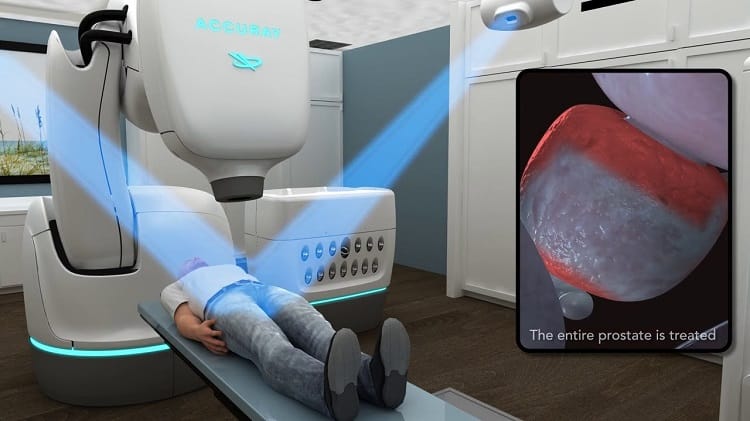A prostate cancer diagnosis isn’t often a “death sentence” however, many men who receive this diagnosis are stricken with grief. Prostate cancer is often linked to prostate surgery, which is can often lead to painful and irritating side effects such as incontinence and impotency. In efforts to avoid this, many men who have been diagnosed with prostate cancer will postpone their treatment or avoid their urologist and/or oncologist altogether.
With the help of new medical and technical advances, adult and elderly men can get effective and easy prostate cancer treatment without surgery, anesthesia, or painful side effects.
The Risks of Surgery for Prostate Cancer Treatment

Prostate cancer and traditional treatments such as surgery can seriously affect a patient’s lifestyle and bodily functions including urinary and bowel movements and sexual functions. Many patients who have been diagnosed with prostate cancer are referred to surgery for treatment. Surgery has been the traditional treatment plan because it’s suitable for a range of ages and stages of prostate cancer and has been relatively effective. However, it comes with many risks and side effects. As technology has improved, and treatment options have expanded, surgery should only be used for extreme cases.
To begin a radical prostatectomy, the surgical procedure for prostate cancer treatment, the patient will be administered general anesthesia before surgery. This can produce an adverse reaction, especially in elderly patients.
The surgery itself requires an 8-to-10-inch vertical incision below the belly button to remove the prostate gland. As in any surgical procedure, there’s a huge risk of infection. As sterilized as an operating room may be, there’s never a 100% bacteria-free zone. Even following the surgery, many patients go home and are unable to properly care for their incision site, which can further increase their risk of infection.
Following the procedure, patients will need to use a catheter for urinating. This may be required for up to two weeks post-surgery. Patients will also need to reduce their activity levels since there can be no heavy lifting or strenuous activity for up to a month post-surgery. Many have to take weeks off of work, which can further impact the patient’s finances.
Even following the recovery period, patients may experience lifelong side effects. Some of the most common results of radical prostatectomy include urinary incontinence and erectile dysfunction. While these do not pose a serious health risk, these side effects can be incredibly upsetting to patients that now have to deal with them for the remainder of their lifetime.
During a radical prostatectomy, surgeons often also perform a pelvic lymphadenectomy. This procedure removed the lymph nodes to determine if the cancer has spread. This often results in complications caused by an accumulation of lymphatic fluid in the pelvic area.
Prostate cancer surgery is a highly invasive procedure that can rid patients of one problem but cause much more. Instead of having to undergo incisions, anesthesia, and a lengthy recovery period, it’s much more beneficial and simpler for prostate cancer patients to receive radiation therapy for prostate cancer treatment.
How Radiation Therapy Treats Prostate Cancer
According to the Prostate Cancer Foundation, every year over 60,000 men in the United States choose radiation therapy to treat prostate cancer. Not only is radiation therapy non-invasive, but it also requires no anesthesia, no recovery period, and minimal side effects.
There are various types of radiation therapies available for cancer treatment, but because of the size and location of the prostate gland, not all of these are suitable for efficient and effective prostate cancer treatment. Stereotactic Body Radiation Therapy (SBRT) is the best option for prostate cancer because it can administer high doses of radiation to a pinpointed region.
SBRTs use advanced imaging and targeting technologies to identify the location of the tumor and deliver high levels of radiation directly to the site. This results in fewer required treatment sessions than traditional radiation therapy. Traditional radiation requires 30 – 45 treatment sessions where SBRT requires only 2-5 treatment sessions.
The CyberKnife System is a state-of-the-art form of SBRT and is a highly effective prostate cancer treatment. Along with a shorter treatment period, CyberKnife Radiation Therapy for prostate cancer offers many benefits to patients.
Benefits of CyberKnife Radiation Therapy for Prostate Cancer

The CyberKnife system pairs the imaging technologies of SBRT with highly advanced robotics to allow the radiation beam to move around the patient. This allows the tumor to be targeted and hit with high-dose radiation from various angles. Cyberknife remains focused on the cancerous cells in the prostate with millimeter accuracy. Since CyberKnife can track the targeted area, the natural movements of the prostate do not interfere with treatment. This results in efficiency with minimal to no damage to healthy surrounding tissue.
Patients can also enjoy a reduced risk of side effects. Most patients experience little to no side effects. Most of them can retain the same urinary, sexual, and bowel functions. Some may experience tiredness, slight dizziness, urinary or rectal irritation after treatment. These symptoms can disappear within a few weeks. In comparison to traditional radiation therapy, CyberKnife also has a lower risk of toxicity. Even though the dose of radiation is higher, the area of delivery and impact is significantly smaller. Best of all, it has a 98% success rate.Medical Director of the CyberKnife Center of Miami, Dr. Mark Pomper says, “CyberKnife has been FDA approved for over 20 years. It has shown an excellent long-term prognosis for patients who have been treated with this type of radiation therapy. Research proves CyberKnife is as effective as standard radiation using 5 treatments instead of 42 with few if any side effects.”

